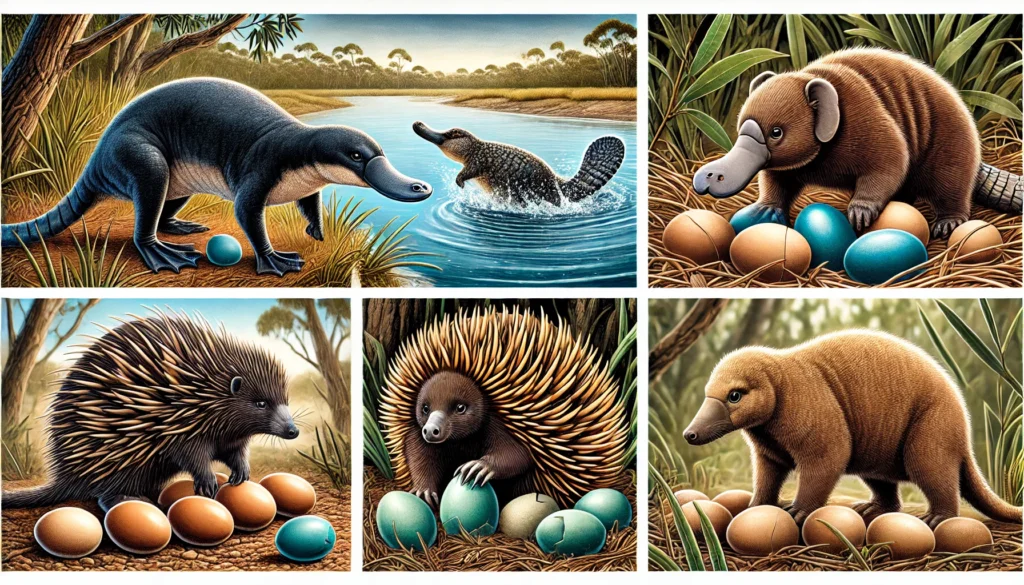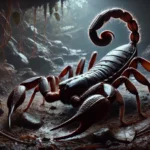When most people think of mammals, they picture animals that give birth to live young. However, a small and fascinating group of mammals defies this norm by laying eggs. These rare creatures, known as monotremes, are a reminder that the animal kingdom is full of surprises. In this article, we’ll explore five incredible mammals that lay eggs and explain how they’ve adapted to their unique reproductive strategies.
1. Platypus
The platypus is undoubtedly the most famous of the egg-laying mammals. Found in freshwater habitats across eastern Australia and Tasmania, this unusual creature is known for its duck-like bill, webbed feet, and flat tail. The platypus is a semiaquatic mammal, spending much of its time hunting for food underwater.
Despite its mammalian characteristics, the platypus lays eggs. The female platypus typically lays one to three soft-shelled eggs in a burrow near water. She incubates them by curling her body around the eggs for about 10 days until they hatch. Once the eggs hatch, the mother produces milk, but unlike most mammals, the platypus doesn’t have nipples. Instead, milk seeps through the skin on her belly, and the young lick it off.
Evolutionary Marvel
The platypus is an evolutionary enigma, combining traits from mammals, birds, and reptiles. Scientists believe that its egg-laying ability is a holdover from its reptilian ancestors. However, despite its primitive egg-laying, the platypus is highly adapted for its environment, using electroreception in its bill to detect prey underwater.
2. Short-Beaked Echidna
The short-beaked echidna is another well-known monotreme, native to Australia and New Guinea. Echidnas resemble hedgehogs or porcupines, with their spiny coats providing protection from predators. While their appearance is striking, their reproductive habits are even more fascinating.
Female echidnas lay a single leathery egg, which they place into a special pouch on their abdomen. After about 10 days, the egg hatches, and a tiny, underdeveloped baby echidna, known as a puggle, emerges. The puggle remains in the mother’s pouch for several weeks, feeding on milk that is secreted through specialized mammary glands. Like the platypus, echidnas don’t have nipples, so the puggle licks milk from the skin.
Incredible Survival Skills
Echidnas are expert diggers, using their strong claws and long snouts to forage for insects, worms, and termites. Their spines, similar to those of porcupines, provide a strong defense against predators. Despite their primitive reproductive methods, echidnas are highly adaptable and thrive in a variety of environments.
3. Long-Beaked Echidna
Closely related to the short-beaked echidna, the long-beaked echidna is found in the forests of New Guinea. As its name suggests, this species has a longer snout, which it uses to forage for worms and insects in the dense undergrowth. Like its short-beaked cousin, the long-beaked echidna is an egg-laying mammal.
The reproductive process is similar: the female lays a single egg and places it in her pouch, where it hatches after 10 days. The young echidna stays in the pouch, feeding on the mother’s milk until it is developed enough to survive outside. While long-beaked echidnas are less well-known than platypuses and short-beaked echidnas, they are equally fascinating and share many of the same reproductive traits.
Endangered Species
Unfortunately, the long-beaked echidna is an endangered species, primarily due to habitat loss and hunting. Conservation efforts are in place to protect these unique mammals, but their populations remain small and vulnerable.
4. Western Long-Beaked Echidna
The western long-beaked echidna, another variation of the long-beaked echidna, is found in the highlands of New Guinea. This species is distinguished by its even longer snout and its preference for colder, mountainous habitats. Like other monotremes, it lays eggs, with a reproductive process almost identical to the other echidna species.
What sets the western long-beaked echidna apart is its specialized diet. While other echidnas primarily feed on insects, this species has adapted to eat earthworms and other soft-bodied invertebrates. Its elongated snout allows it to probe deep into the soil to find food, while its strong claws enable it to dig through tough terrain.
Adaptation to Harsh Environments
The western long-beaked echidna has developed several adaptations that allow it to survive in its challenging environment. Its thick coat of spines provides insulation against the cold, and its ability to lay eggs allows it to conserve energy during reproduction, which is vital in nutrient-poor habitats.
5. Eastern Long-Beaked Echidna
The eastern long-beaked echidna is another variant of the long-beaked echidna family, inhabiting the lowland forests of New Guinea. Like its relatives, it lays eggs, and its reproductive cycle mirrors that of the other echidnas. What makes the eastern long-beaked echidna unique is its preference for wetter, more tropical environments.
Despite sharing many characteristics with other echidnas, the eastern long-beaked echidna has developed several adaptations to thrive in its rainforest habitat. Its longer snout helps it forage for food in the thick underbrush, and its sharp claws allow it to navigate the dense forest floor with ease.
Conservation Concerns
The eastern long-beaked echidna, like its western cousin, faces significant conservation challenges. Deforestation and hunting have reduced its numbers, and conservation efforts are ongoing to protect its habitat and ensure the survival of this extraordinary species.
How Do Egg-Laying Mammals Differ From Other Mammals?
While most mammals give birth to live young, monotremes like the platypus and echidna lay eggs. This reproductive strategy is considered more primitive, as it is a trait shared with reptiles and birds. However, monotremes are still classified as mammals because they share key mammalian traits, such as:
1. Milk Production
All mammals, including monotremes, produce milk to nourish their young. While monotremes lack nipples, they have specialized mammary glands that secrete milk, which the young lick from the skin.
2. Warm-Blooded
Monotremes are warm-blooded, meaning they maintain a stable internal body temperature, just like other mammals. This allows them to survive in a variety of environments, from the cold highlands of New Guinea to the temperate rivers of Australia.
3. Fur or Hair
Monotremes are covered in fur or hair, which helps them regulate their body temperature and provides protection from the elements. The spines of echidnas are actually modified hairs, offering both insulation and defense.
4. Live Young After Hatching
Although monotremes lay eggs, their young are born at a very early stage of development and rely on their mothers for nourishment and protection, similar to live-born mammalian offspring.
Why Do These Mammals Lay Eggs?
The evolutionary reason behind why these mammals lay eggs is a matter of scientific debate. Some experts believe that monotremes represent an ancient lineage of mammals that retained the egg-laying trait from their reptilian ancestors. Over millions of years, other mammals evolved to give birth to live young, but monotremes maintained this more primitive reproductive strategy.
Despite this, monotremes have thrived in their respective environments, proving that egg-laying is still a viable reproductive method. In fact, laying eggs may offer certain advantages, such as reducing the physical strain on the mother during pregnancy or allowing her to protect her young more effectively.
Conclusion
The world of monotremes is a reminder that the animal kingdom is full of surprises. These five mammals that lay eggs—the platypus, short-beaked echidna, long-beaked echidna, western long-beaked echidna, and eastern long-beaked echidna—are evolutionary marvels, combining traits from reptiles, birds, and mammals in unique ways. While their reproductive methods may seem strange, these creatures have adapted to their environments and continue to thrive in some of the most challenging habitats on Earth.
FAQ
Do any mammals lay eggs?
Yes, there are five known species of mammals that lay eggs: the platypus and four species of echidnas (short-beaked echidna, long-beaked echidna, western long-beaked echidna, and eastern long-beaked echidna). These mammals belong to a group called monotremes.
How do monotremes differ from other mammals?
Monotremes differ from other mammals primarily in their reproductive strategy. Unlike most mammals, which give birth to live young, monotremes lay eggs. However, they still produce milk to nourish their young and possess other mammalian traits like being warm-blooded and having fur.
Why do platypuses lay eggs?
Platypuses lay eggs as part of their evolutionary lineage. Scientists believe that monotremes like the platypus retained the egg-laying ability from their reptilian ancestors. Despite this primitive trait, platypuses are well-adapted to their environment and thrive in their aquatic habitats.
How do echidnas care for their young?
After laying a single egg, female echidnas place the egg in a pouch on their abdomen. Once the egg hatches, the baby echidna, or puggle, remains in the pouch, feeding on milk secreted through the mother’s skin until it is old enough to leave the pouch and develop further.
Are monotremes endangered?
Some species of monotremes, particularly the long-beaked echidnas, are endangered due to habitat loss and hunting. Conservation efforts are underway to protect these unique species and their habitats.
Do monotremes produce milk like other mammals?
Yes, monotremes produce milk to feed their young. However, they do not have nipples. Instead, milk is secreted through specialized mammary glands, and the young lick it from the mother’s skin.


